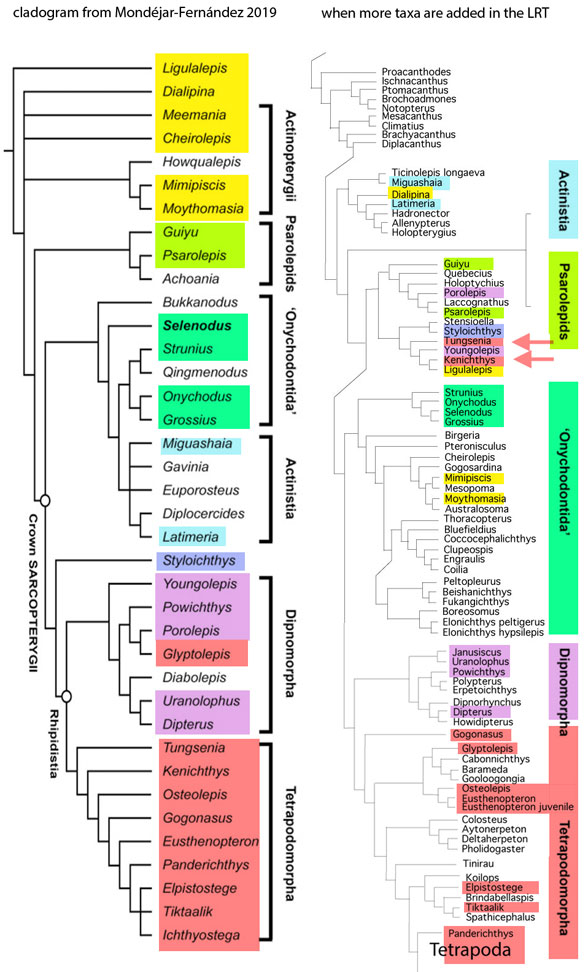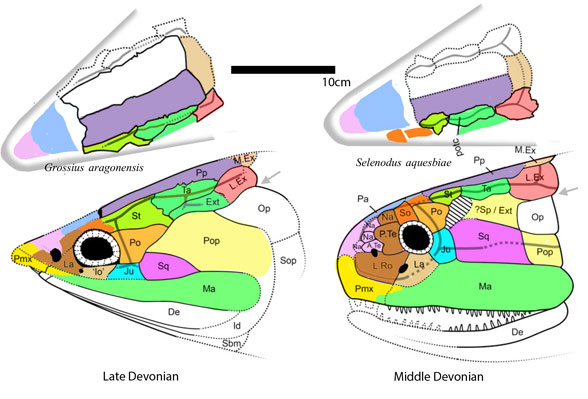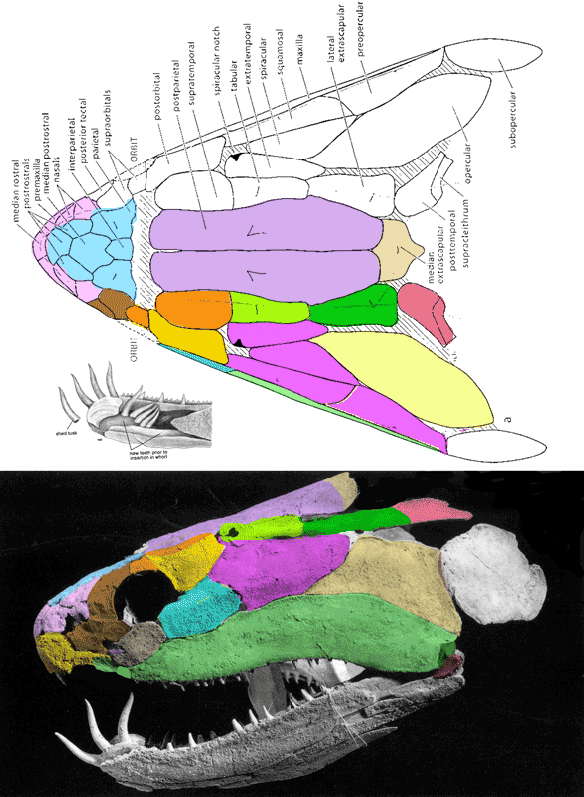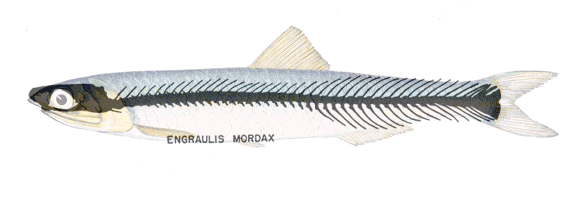Traditional fish cladograms
split ray fin fish from lobe fin fish at the origin of all bony fish. At first glance, that split seems completely reasonable, but is it wise to put all your faith in this one trait?
Unfortunately,
that’s just the kind of trap the late professor Larry Martin reveled in. Try to avoid “Pulling a Larry Martin” because convergence is always around the corner ready to bite. According to the large reptile tree (LRT, 2014 taxa; subset Fig. 2) the separation of lobe fins from ray fins at the origin of all bony fish is a traditional myth still taught at the university level. Testing (Fig. 2 right) shows taxon exclusion is once again the issue.
Closer examination
shows some lobe fin taxa (e.g. Quebecius) had pectoral lobe fins and pelvic ray fins (Fig. 1).
Closer examination
shows some taxa had one kind of lobe fin (e.g. Stensioella) without any trace of rays. Others had a different sort (e.g. Latimeria, Dipterus; Eusthenopteron) with a ray fin fringe or brush. Some traditional ray fins (e.g. Polypterus) have lobe fins. And… we’re not even considering spiny sharks (e.g. Acanthodes) and kin (e.g. Bonnerichthys, Pachycormus). The LRT nests spiny sharks and kin at the base of the lobefin clade (Fig. 2 right).
Phylogenetic analysis
(Fig. 2 right) indicates taxa with a pectoral lobe fin do not form a monophyletic clade (unless it includes a long list of intervening and derived ray-fins). You won’t learn this at the university level as demonstrated by Mondéjar-Fernández (Fig. 2 left) and the cherry-picked cladograms he borrowed and trusted.

In 2019 Mondéjar-Fernández
(Fig. 1 left) chose a tiny skull-only taxon, Ligulalepis, as the outgroup taxon for both ray fins and lobe fins, then nested five putative fossil ray fins (without resolution) basal to several lobe fin clades leading to tetrapods. Mondéjar-Fernández was attempting to nest the onychodontid Selenodus (Fig. 3) and resolve long-standing issues.
Try to never ‘choose’ an outgroup taxon. Instead try to build your own cladogram with so many taxa that the cladogram itself tells you which taxa are suitable outgroups.

Mondéjar-Fernández reported,
“in recent analyses, the position of onychodonts as the sister group of coelacanths has been solidly established.”
After testing, (Fig. 1) the LRT does not support this hypothesis of interrelationships.
Two nodes separate onychodonts and coelacanths in the LRT.
Mondéjar-Fernández also reported,
“when further taxa (e.g. Qingmenodus, Grossius and Bukkanodus) are taken into account to investigate onychodont interrelationships, both within the group and among sarcopterygians, the supposedly well-established monophyly is challenged.”
You might remember,
onychodontids develop a medial dentary tooth whorl, convergent with the one found in Helicoprion.
Mondéjar-Fernández reports,
“The dental material of Selenodus is too incomplete or too small to assign any of the isolated teeth to the parasymphysial tooth whorl.”
That’s okay. We don’t rely on one or a few traits to determine relationships in the LRT. We use every multi-state trait in the matrix. ‘Medial tooth whorl’ is so rare it is not used in the LRT.

Mondéjar-Fernández reports,
“In order to assess the phylogenetic position of Selenodus, the data matrix assembled by Lu et al. (2016a) in their survey of onychodonts based on Qingmenodus was used. (Fig. 1 left)”
Try not to borrow someone else’s cladogram.
That involves too much trust both in scoring and taxon inclusion.
Mondéjar-Fernández reports,
“Ligulalepis, Dialipina and the ‘actinopterygian Meemannia, Cheirolepis, Mimipiscis and Moythomasia were designated as outgroup.”
Try not to designate taxa as outgroup. That involves too much luck, belief and bias. It is ironic that these last four ‘outgroup taxa in Mondéjar-Fernández nest as ingroup onychodontids in the LRT. Taxon exclusion, cherry-picking taxa and academic traditions blinded the author to this possibility. Unfortunately, Mondéjar-Fernández represents the majority of paleo workers. Who among them has broken free with radical hypotheses based on adding taxa? No one.
Mondéjar-Fernández reports,
“The analyses gave 980 equally parsimonious trees [for 38 taxa, 242 characters].“
That loss of resolution means it’s time to add more taxa. By comparison the LRT is fully resolved with nearly 10x more (= 373) taxa and 14 fewer characters.
Some members of the Onychodontida are extant.
Engraulis, the anchovy (Fig. 6) is an example (Fig. 1). Fish workers never add anchovies to lobe fin and onychodontid cladograms because anchovies don’t have lobe fins. The LRT does not elevate one trait over the rest. The LRT tests hundreds of fish using hundreds of characters.
Don’t work so hard
trying to cherry pick taxa appropriate for your own lobe-fin and onychodontid studies. Don’t expose yourself to error and colleague criticism due to taxon exclusion. Test more than enough taxa and let the software sort it all out for you. Your own LRT will be a powerful tool that will recover obvious interrelationships the human brain has not been able to imagine without it.
Selenodus aquesbiae (Mondéjar-Fernández 2019; Middle Devonian) has a large maxilla and large prefrontal. Here it nests with Grossius and Onychodus.
Grossius aragonensis (Schultze 1973; Late Devonian) has a straight rostrum distinct from related taxa.
References
Mondéjar-Fernández J 2019. A new onychodont (Osteichthyes; Sarcopterygii) from the Middle Devonian of Morocco and its bearing on early osteichthyan evolution. Journal of Systematic Palaeontology 0: 1–34. http://dx.doi.org/10.1080/14772019.2019.1655495
wiki/Strunius
wiki/Onychodus
wiki/Grossius
wiki/Selenodus – not listed yet
wiki/Onychodontiformes
wiki/Osteichthyes



